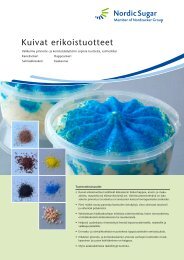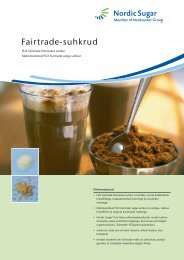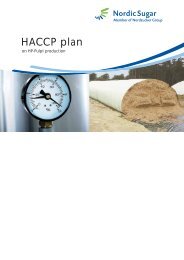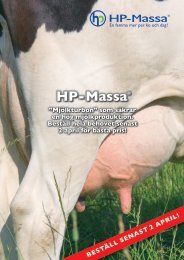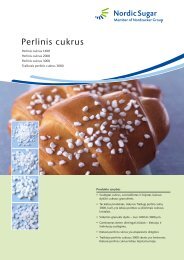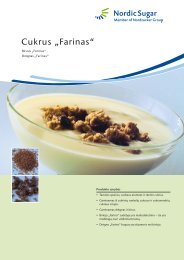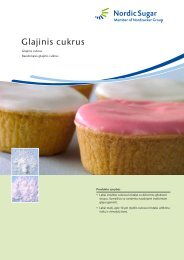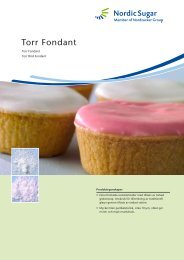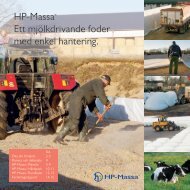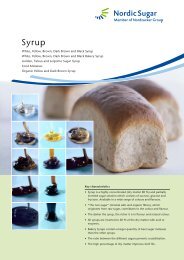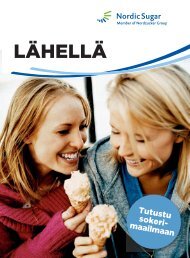HACCP plan
English - Nordic Sugar
English - Nordic Sugar
You also want an ePaper? Increase the reach of your titles
YUMPU automatically turns print PDFs into web optimized ePapers that Google loves.
Content<br />
1. Objectives<br />
1. Objectives<br />
2. The method<br />
3. Identification of<br />
CCPs and POAs<br />
4. Verification process<br />
5. Documentation<br />
The objectives with this booklet are to<br />
1. Explain and introduce Nordic<br />
Sugar’s <strong>HACCP</strong> work to customers<br />
and authorities<br />
2. Exchange general experiences with<br />
<strong>HACCP</strong> <strong>plan</strong>s throughout the<br />
organisation<br />
3. Create a common understanding<br />
of the <strong>HACCP</strong> method<br />
(calibration between factories)<br />
The current <strong>HACCP</strong> <strong>plan</strong> adresses<br />
product safety associated with<br />
production of pelletized dried sugar<br />
beet pulp (e.g Betfor®/Kosetter®).<br />
2. The method<br />
The <strong>HACCP</strong> <strong>plan</strong>s at Nordic Sugar are<br />
based on the GMP+ method (International<br />
Feed Ingredients Standard - IFIS)<br />
and the international food safety<br />
standard ISO 22000. We have taken<br />
every identified hazard in the whole<br />
process chain and evaluated them<br />
with regard to three basic steps in this<br />
method (the fourth step below is the<br />
verifi cation of the system). This<br />
procedure has clarified where the<br />
hazard should be controlled, how the<br />
hazard should be controlled and what<br />
verification procedures are necessary.<br />
1. Identification of chemical, physical,<br />
biological and allergenic hazards in<br />
each step of the process chain.<br />
2. In a risk assessment (2.2.) the<br />
severity and probability of each<br />
identified hazard are combined to<br />
determine the risk class and the type<br />
of control method necessary.<br />
3. By using the decision tree (2.3.) we<br />
have identified where the hazards<br />
should be controlled along the<br />
production chain. Based on the risk<br />
classes the decision tree is used to<br />
determine whether a given process<br />
step is a critical control point (CCP), a<br />
point of attention (POA/GMP) or just a<br />
periodic measure (PM).<br />
4. Apart from product specifications,<br />
process diagrams, risk analysis tables<br />
and summary tables, also activities<br />
towards verification of the <strong>HACCP</strong><br />
system are do cumented. These<br />
activities are e.g. audits, sampling and<br />
analysis of products, analysis of<br />
deviations and customer complaints.<br />
2.1. Severity<br />
and probability<br />
The severity of every possible hazard in<br />
the production chain has been<br />
estimated by the Nordic Sugar <strong>HACCP</strong><br />
Reference Group independent of the<br />
current production process. The<br />
probability of each hazard is very<br />
closely associated with the processes<br />
and the current process equipment.<br />
The probability has therefore been<br />
determined by the local <strong>HACCP</strong> group<br />
at the factory.<br />
- 2 -



